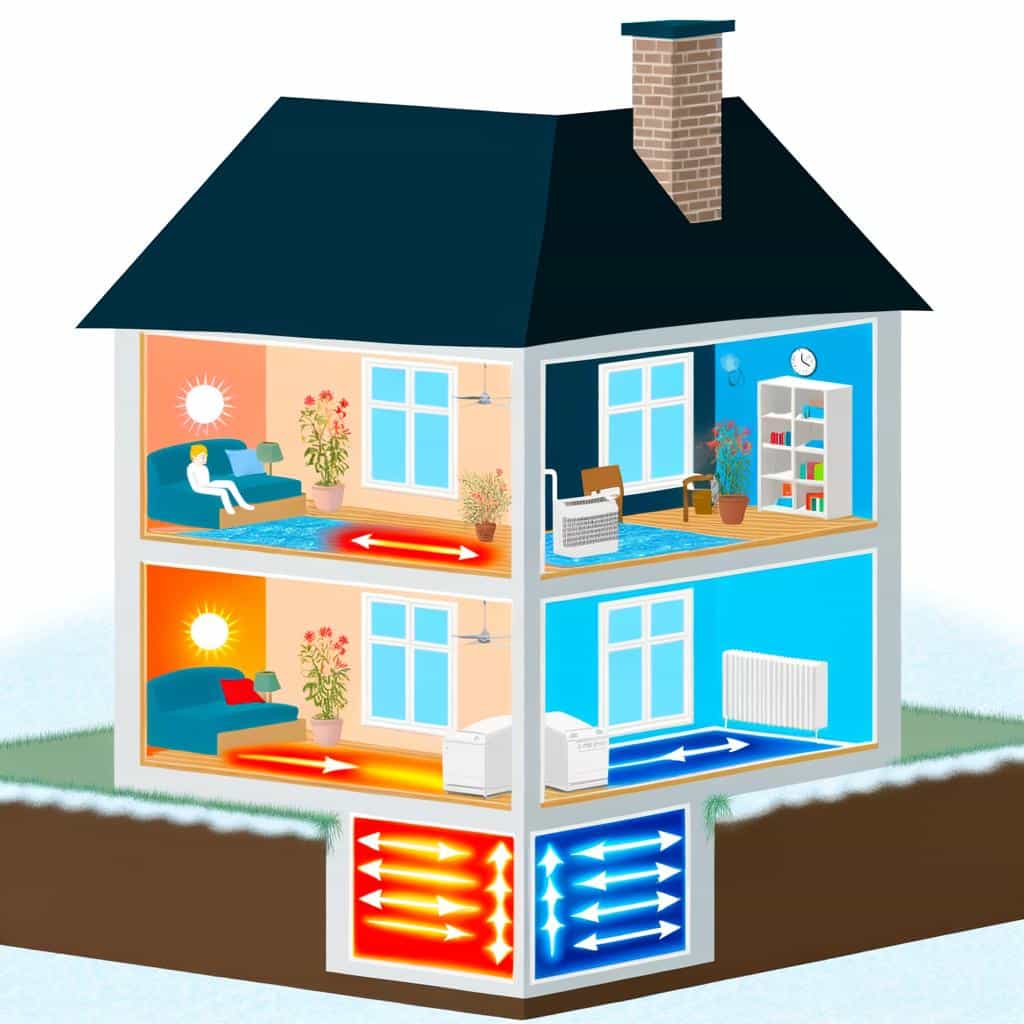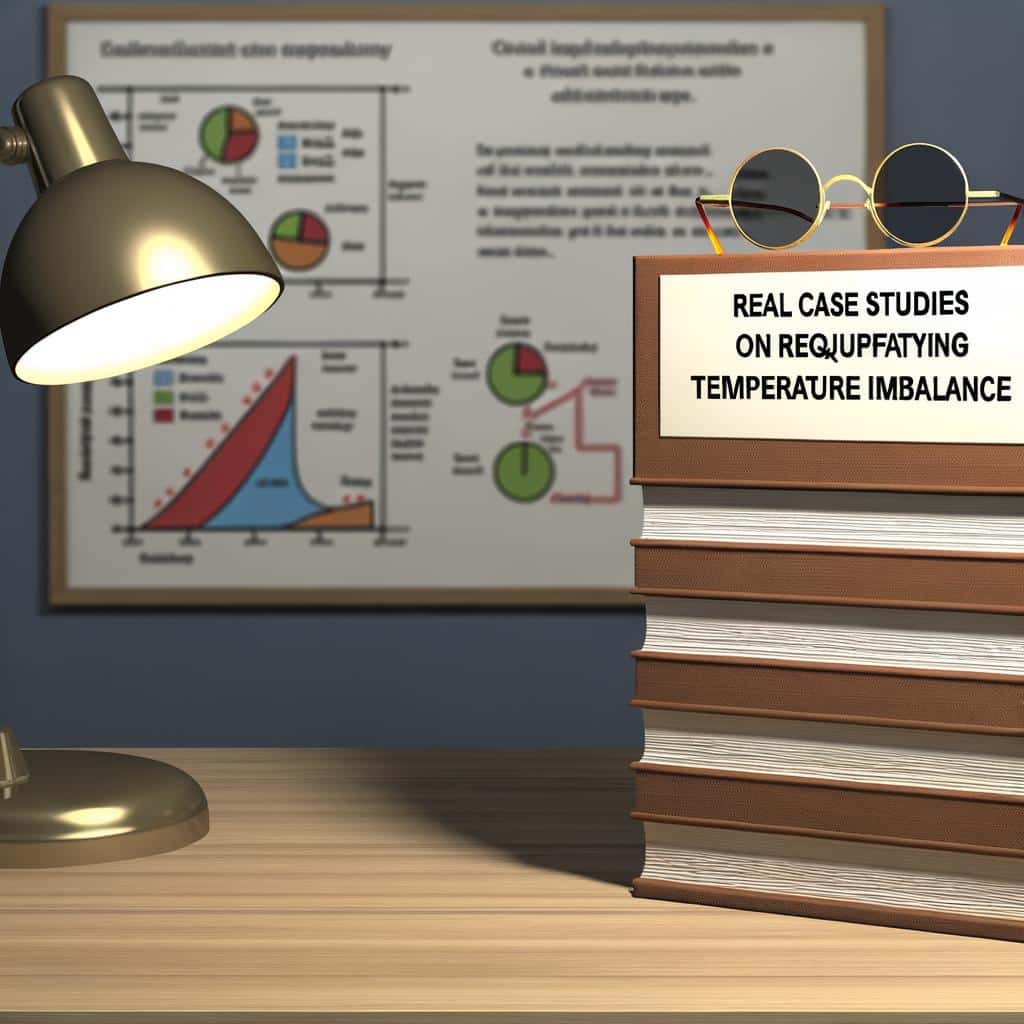As the sun rises and sets, throwing shifts of temperature across the Earth, we humans have designed our safe havens to offer us the comfort of consistent warmth or cold, as required. Yet, there are moments where, inside the very heart of our homes, we stumble upon miniature weather fronts — the hot & cold spots. Sometimes, it might be that arctic chill in your hallway, at others, the sudden tropical wave hitting as you enter the attic. What mysterious convection brews these anomalous climates right within our cozy abodes? Welcome on-board as we embark on a fascinating voyage into the invisible thermal landscapes of our homes, decode the science shrouding these perplexing hot and cold spots, and offer you scientific explanations to dispel the mists of misunderstanding.
Exploring the Basics: What Causes Hot & Cold Spots at Home?
Jumping from the cosy warmth of your living room into an icy-cold bedroom, or walking from a balmy kitchen into a freezing hallway is something most homeowners have experienced. These unusual microclimates, often referred to as hot and cold spots, are primarily caused by uneven heating or cooling within the house. But what leads to such inconsistencies and how can these be addressed?
One of the most common causes of these irregularities is inefficient insulation. Poorly insulated spaces tend to lose heat during winter and gain it during summer, resulting in uncomfortable temperature fluctuations. Similarly, air leakage – through gaps or cracks in windows, doors, and other openings – can let conditioned air escape and unconditioned air sneak in, creating hot or cold zones. Another factor could be the location and type of windows in your home. Energy can easily pass through glass, so rooms with large or numerous windows might feel colder or hotter than the rest of the house depending on the season.
- Poor Insulation: Results in heat loss/gain leading to temperature inconsistency.
- Air Leakage: Causes escape of conditioned air and infiltration of unconditioned air.
- Windows: Large or numerous windows can cause variations in room temperatures.
| Issue | Solution |
|---|---|
| Poor Insulation | Install high-quality insulation |
| Air Leakage | Seal any cracks or gaps |
| Windows | Install energy-efficient windows or use heavy curtains |
It’s important to understand that these hot and cold spots make your HVAC system work overtime, driving up your energy bills and reducing your home’s overall comfort level. Noticing this thermal imbalance is the first step towards resolving it. By identifying the problem areas and addressing the underlying issues, you can effectively improve the thermal comfort of your home.

Peeling Back the Layers: Insulation and Its Role in Temperature Regulation
Heat transfer is a thermal mystery frequently experienced in homes. It’s the process by which warmth moves from one area to another: from your heated living room to the frigid outdoors, or from the blazing summer sun to your comfortable, air-conditioned bedroom. A crucial player in these heat exchanges? Insulation. This unsung hero lives in the walls, roof, and floors of your home, taking on the critical role of slowing – and ideally stopping – undesirable heat transfer.
So let’s take a closer look at the science. The primary forms of heat transfer are: conduction, the process that heats your soup when you put a pot on a hot stove; convection, the reason why you feel hot air above a radiator and cold air below; and radiation, which lets the sun warm your face from 93 million miles away. Insulation works primarily against conduction and convection, employing materials such as fiberglass, cellulose, or foam that are poor conductors of heat.
Imagine, if you will, a cross-section of a typical insulated wall:
| On the outside | The exterior cladding and sheathing, bearing the brunt of the weather. |
| Next in line | The insulating layer, quietly reducing heat transfer. |
| Finally, interior | Drywall and paint, the walls as we commonly know them. |
The quality and quantity of your insulation determine how much heat passes through this wall barrier.
- Higher-quality insulation tends to have higher R-values, a measure of resistance to heat flow. Look for insulation with an R-value appropriate to your geographic location and specific home needs.
- More insulation is not always better. Too much can lead to moisture problems, while too little allows for excessive heat transfer. Balance quantity with the specific needs of your home and local climate.
Understanding insulation helps us discover the reasons behind the hot and cold spots within our homes. Energy audits or thermal imaging can be extremely useful in identifying areas where insulation might be lacking or ineffective. This understanding can lead to smarter choices, enhanced comfort, and considerable savings on energy bills.

Windows to the World: The Impact of Glazing on Home Temperatures
In your home, you have probably noticed certain areas that feel warmer or chillier than others. These aren’t ghostly hotspots; they are the results of thermal shifts caused by various factors. Today, we leap into the world of glazing and its role in these house temperatures.
The art of glazing has a significant influence on this whirling dance of temperatures within your domestic boundaries. Window glazing” is the term used to describe the glass part of a window – a seemingly innocent component but with massive sway over your energy bills and overall comfort. There are three types of window glazing namely single, double and triple-glaze.
- Single-Glaze: Contains a single pane of glass. It is usually found in older homes and tends to permit heat and cold to easily pass through.
- Double-Glaze: Contains two panes of glass separated by a gas or vacuum layer. This insulating layer is what helps regulate temperatures and energy usage in your home.
- Triple-Glaze: Comprises three panes of glass and two insulating layers. Although costlier, they are excellent at maintaining a steady temperature within your home, even in extreme weather.
| Glazing Type | Weather Appropriateness | Benefits |
|---|---|---|
| Single-Glaze | Mild climates | Low cost |
| Double-Glaze | Moderate to Cold climates | Energy efficient, temperature regulating |
| Triple-Glaze | Extremely Cold climates | Superb energy efficiency, excellent temperature regulation |
So, the mystery of those strange thermal shifts in your home emerges as the play of window glazing. Understanding this is not just fanciful knowledge, but useful in making more informed decisions about glazing options suitable for your climate and comfort needs. Ultimately, unraveling these mysteries lets you keep your cool (and your warmth) in a smarter, more energy-efficient way.

The Hidden Culprits: Leaks and Drafts that Cause Temperature Discrepancies
Imagine waking up to a warm cozy room, then stepping outside your room into a jarringly cold corridor, or, perhaps, you’re confronted by the hot blast of air when opening a door to the upstairs floor – that’s your house presenting a thermal mystery to you. If you’ve wondered why, know that you’re not alone in experiencing “hot and cold spots” in the house. One of the often overlooked reasons for temperature discrepancies could be drafts and unobtrusive leaks.
A common scenario is the appearance of winter drafts that create cold, often uncomfortable zones in your domicile. They’re often the result of ill-fitted windows, doors, and even mail slots. Here’s a simple list of areas you might want to check for drafts:
- Windows
- Doors
- The attic hatch
- Electrical outlets
- Anywhere with exterior plumbing
On the flip side, leaks and unsealed air ducts can be the stealthy culprit introducing hot spots in your chilly winter paradise. Such leaks allow cold air in while the warm air seeps out, leading to a drastic temperature difference. Leaky ductwork means the air intended for a particular room or zone ends up slipping out, thereby causing an imbalance in heating. Check these potentially problematic areas regularly:
- Unsecured duct joints
- Insulation gaps
- Holes or cracks in duct walls
- Loose duct tapes
To consolidate, here is a quick comparison of draft and leak-prone places and their related issues in a handy table:
| Draft/Leak-Prone Places | Issues |
|---|---|
| Windows, Doors, Attic Hatch | Winter drafts causing cold zones |
| Electrical Outlets, Plumbing Exterior | Temperature drop due to cold drafts |
| Unsecured Duct Joints, Insulation Gaps | Leaky hot spots in winter |
| Holes/Cracks in Duct Walls, Loose Duct Tapes | Imbalance in heating due to escaping warmed air |

Invisible Factors: How Home Layout and Design Influence Temperature
Have you ever marvelled at the way temperatures fluctyate within your home, even between adjacent spaces? This puzzle often baffles homeowners, who find it hard to understand why certain rooms are colder or hotter than others. But the answer lies in the intricate web of factors that influence your home’s internal thermal ecosystem. Among the most astoundingly covert influences are your home layout and design.
Subtle aspects such as room positions, the material of construction, and even your home’s orientation in relation to the sun, play significant roles in these dynamic temperature shifts. For instance, rooms on the east and west sides of a home are generally warmer due to the daily arc of the sun. Similarly, rooms with high ceilings tend to be cooler because warm air rises upwards. Aside from room layout, your home’s construction components can also impact temperature. For instance:
- Wall composition: Walls made from brick, stone, or concrete are often cooler as these materials have high thermal mass that helps absorb heat during the day and release it slowly at night.
- Insulation and windows: Properly insulated homes and thermal or double-glazed windows can significantly reduce heat transfer and maintain an even temperature within your home.
- Floor materials: Ceramic tiles, concrete, and stone floors can feel cooler underfoot compared to wood and carpet, which provide better insulation and feel warmer.
| Factors | High Heat Retention | Low Heat Retention |
|---|---|---|
| Orientation | North-South | East-West |
| Wall Material | Brick, Stone | Wood, Vinyl Siding |
| Floor Material | Ceramic, Stone | Wood, Carpet |
Understanding your home’s unique thermal makeup empowers you to make effective, informed decisions for maintaining a comfortable temperature throughout your dwelling. So, the next time you notice an unexpected cold or hot patch, consider these invisible factors and become a master of your home’s microclimate.

Turn the Tide: Effective Solutions for Addressing Hot and Cold Spots
Have you ever wondered why certain areas in your home are notably warmer or cooler than others? These are often referred to as thermal mysteries that create hot and cold spots. An understanding of why they occur, combined with the right solutions, can help you to even out the temperature distribution for a comfortable living environment.
One significant factor affecting temperature uniformity is poor insulation. It’s an exceptionally silent culprit as it’s hidden behind your walls. Areas with inadequate or damaged insulation are prone to excessive heat or cold. Another frequent offender is the improper sizing and installation of your HVAC system. An oversized system can short cycle and lead to uneven temperature distribution, while an undersized one may struggle to maintain your desired comfort level. Let’s take a look at some effective methods to address this thermal conundrum:
- Improve Your Home’s Insulation: This calls for a comprehensive energy audit that checks the insulation status of your entire home. Insufficient or damaged insulation should be replaced or supplemented to prevent heat loss or gain.
- Properly Size Your HVAC System: An HVAC professional can help you size your system accurately based on factors like your home’s size, layout, and insulation.
- Consider Zoning Systems: A zoned system breaks up your home into different areas, each with its thermostat for comfort and efficiency.
- Use of Window Treatments: Curtains, blinds, and shades can control the amount of solar heat entering your home and contribute to the overall thermal equilibrium.
Furthermore, there are smart solutions like programmable thermostats which can automate your home’s heating and cooling based on your patterns, saving energy and creating a balanced indoor climate. Remember, a well-insulated home with a properly functioning HVAC system is half the battle won.
| Solution | Advantages |
|---|---|
| Improved Insulation | Prevents heat loss or gain |
| Properly Sized HVAC System | Even temperature distribution |
| Zoning Systems | Personalized climate control per area |
| Window Treatments | Control solar heat gain |

Success Stories: Real Case Studies on Rectifying Temperature Imbalance
Throughout this post, we’ll be spotlighting some prime examples, shedding light on methods homeowners have utilized to solve the riddles of temperature imbalance in their homes. From drafty abodes to stuffy duplexes, homeowners are putting their detective hats on, investigating and decoding the thermal mysteries—they’re unmasking the root causes of home hot and cold spots, and delivering powerful solutions. The Tale of the Double-Decker Bungalow The residents of this quaint bungalow were grappling with distinctive temperature variations— notably between their upper and lower floors. Upon investigation, they observed poorly-insulated windows as the primary culprit. Exhibiting an outstanding resolution, they replaced their old windows with high-quality, energy-efficient ones. The outcome was a uniform temperature throughout the house, which was something they’d always desired. Not only this, they also noted a reduction in their energy bills. Profit and comfort, what more could they ask for?
- The problem: Varying temperatures between upper and lower floors.
- The detective work: Identified poorly-insulated windows as a key cause.
- The solution: Replaced windows with energy-efficient alternatives.
- The result: Consistent house temperature and lowered energy bills.
The Mystery of the Steaming Sanctuary In another instance, a suburban family were stumped by their unusually warm master bedroom. It was always exuding heat, regardless of the season. The cause? A generously-sized skylight that was bathing the room in sunlight… and excess heat. The family replaced the skylight with an energy-efficient model designed to limit solar heat gain and added insulating window blinds. They immediately experienced a significant temperature reduction, transforming their erstwhile sauna-like bedroom into a cosy and comfortable sanctuary.
| The Issue | Investigation | Solution | Outcome |
|---|---|---|---|
| Overly warm master bedroom | Skylight was increasing room temperature | Replaced skylight, added insulating blinds | Significant temperature reduction |
These success stories highlights the importance of proper insulation and mindful selection of household accessories to maintain a uniform temperature. Everyone loves a good riddle, but when it comes to your home’s comfort, the last thing you want is to find yourself facing a thermal mystery. With a little detective work and the right solutions, you too can achieve temperature balance in your home. In the intricate tapestry of home management, every thread matters – especially when it comes to understanding the thermal comfort of our dwellings. No corner of the house is immune to nature’s whims and our built-in systems’ idiosyncrasies. By demystifying the hot and cold spots in your home, not only do you delve deeper into its architectural mysteries but also add a layer of comfort, efficiency, and cost-effectiveness to your life. Walk those hallways, open those vents, and assess your insulation. It’s time to fine-tune your symphony of temperatures. After all, isn’t home where the perfect temperature is? Let’s continue to troubleshoot, explore, and decode the ever fascinating thermal mysteries of our homes.




